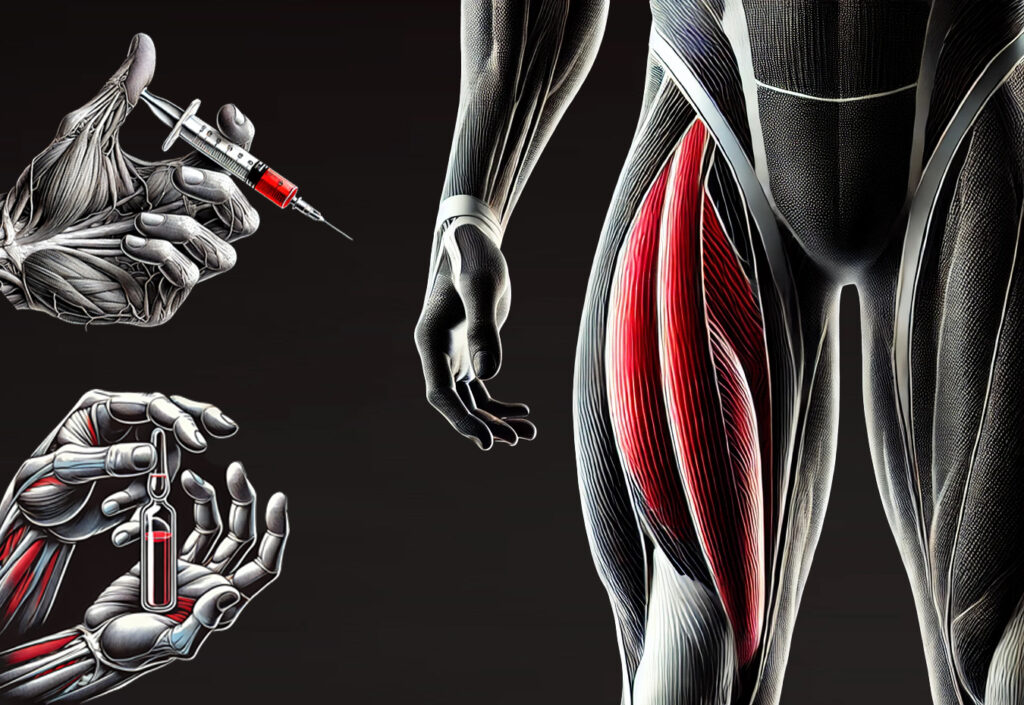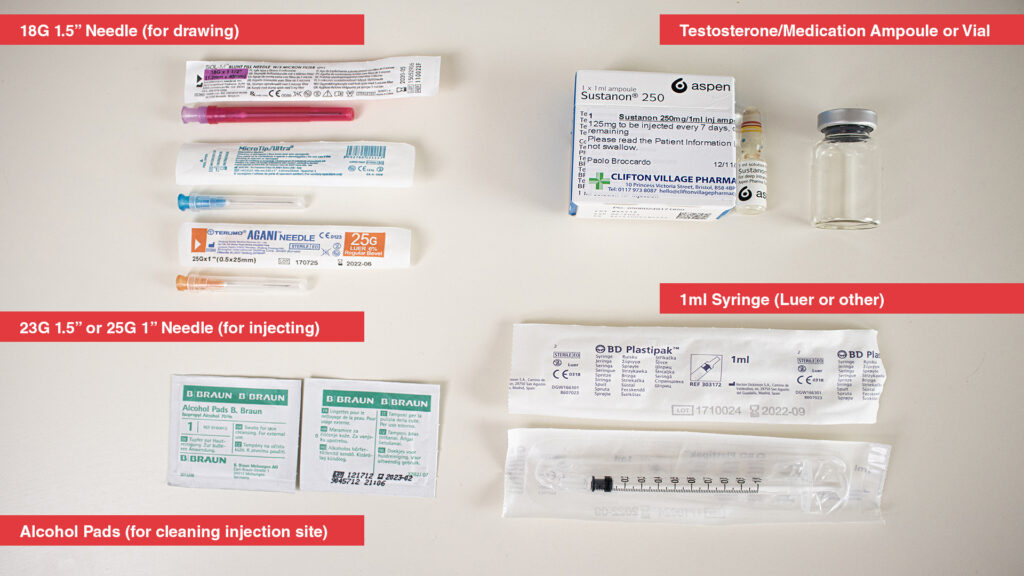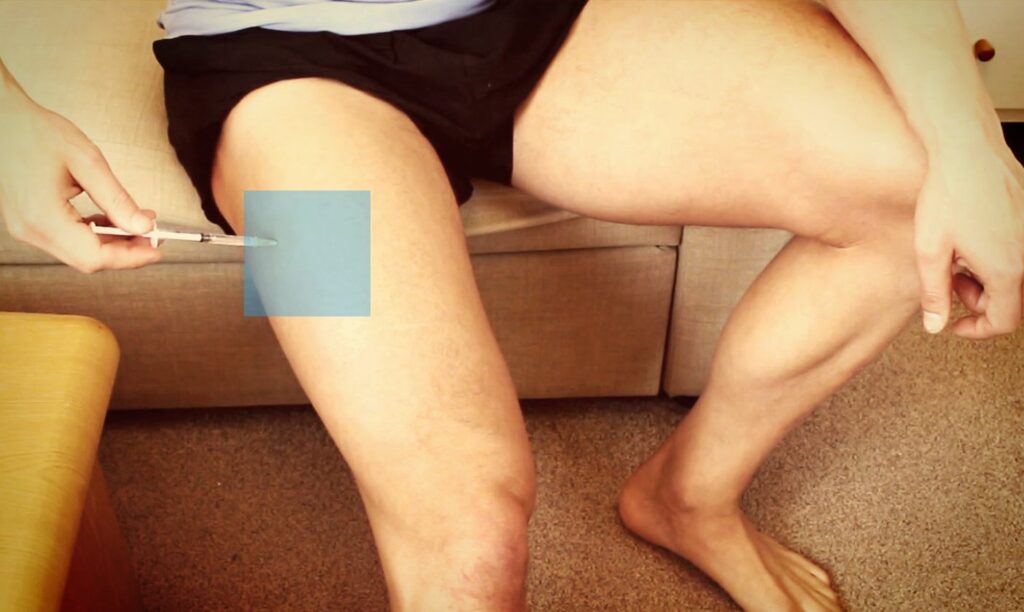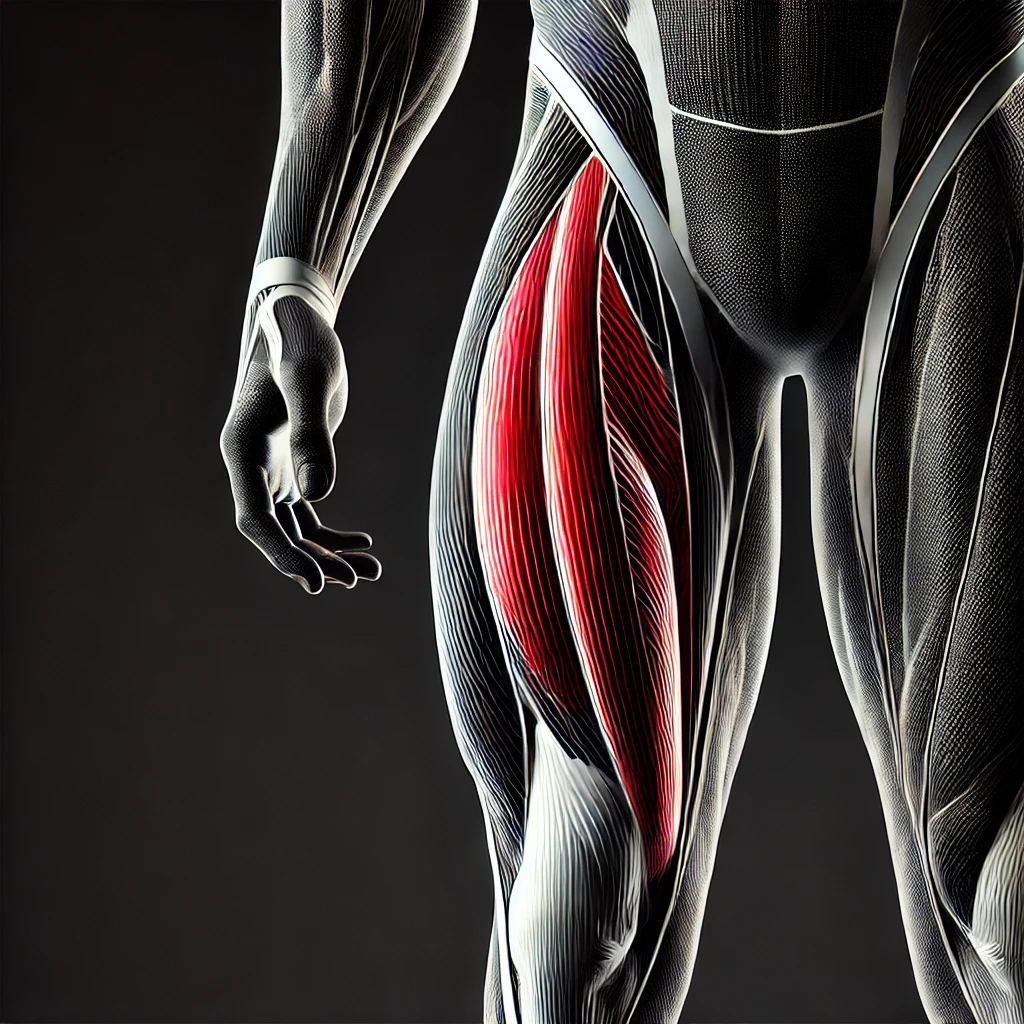How To Do A Quad Injection: A Complete Guide

Last Updated On March 26, 2025
Trying something new, especially when it involves needles, can be intimidating. Quad injections, however, are remarkably straightforward once you learn the proper technique. As the third most commonly used injection site for testosterone replacement therapy (TRT) (after ventrogluteal and deltoid sites), quadriceps injections offer an alternative to other injection methods, with the advantage of being easier to access and administer.
However, this site should be used with caution due to its higher incidence of adverse reactions. This comprehensive guide will walk you through everything you need to know about performing safe, painless quad injections.
What is a Quad Injection?
A quad injection is an intramuscular injection administered into the quadriceps muscle, located on the front of your thigh. This large muscle group consists of four muscles (hence the name “quad”) that extend from your hip to your knee, providing ample space for medication administration.
The quadriceps’ size, accessibility, and relative lack of major blood vessels and nerves make it an ideal injection site, particularly for self-administration. For those on TRT or other regular injection therapies, quad injections offer a convenient alternative that can be easily viewed and accessed without awkward positioning.
For many patients, quad injections become the preferred method once they’ve mastered the technique, due to the straightforward access and visibility of the injection site.
Quad Injections: Advantages and Considerations

Before performing a quad injection, it’s important to understand its specific benefits and limitations compared to other injection sites:
Advantages
- Direct visibility: Unlike glute injections, you can clearly see the injection site
- Easy access: No twisting or awkward positioning required
- Large muscle area: The quadriceps can accommodate various injection volumes
- Fewer major nerves/vessels: Reduced risk of hitting sensitive structures
- Simple self-administration: Particularly beneficial for those who self-inject
Considerations and Disadvantages
- Highest risk of adverse reactions: Quad injections have the highest incidence of complications among the major injection sites
- Risk of hitting nerves and blood vessels: Despite its size, the quadriceps contains significant neurovascular structures that can be damaged
- Severe post-injection pain: Many patients report significant soreness that can last for days and impair mobility
- Potential for intramuscular hematoma: The rich blood supply increases risk of bleeding within the muscle
- Possible muscle damage: Repeated injections in the same area can cause muscle fibrosis or damage
- Walking discomfort: Pain may significantly impact mobility and daily activities
Due to these risks, quad injections should be used with caution and only after becoming proficient with safer sites like the ventrogluteal and deltoid regions. The apparent convenience of this site must be weighed against its substantially higher complication rate.
Equipment Needed for Quad Injections

Proper equipment selection ensures a safe, comfortable quad injection. Here’s what you’ll need:
Essential Supplies
- Your medication (testosterone vial/ampule or other prescribed medication)
- Drawing needle (typically 18G, 1.5 inch)
- Injection needle (typically 23-25G, 1-1.5 inch depending on body composition)
- Appropriate syringe (1ml or 3ml depending on your dose)
- Alcohol swabs/pads
- Cotton balls or gauze
- Bandage/adhesive bandage (optional)
- Sharps container for disposal
Needle Selection Guide
For quad injections, needle selection should account for the depth needed to reach the muscle:
- Drawing needle: 18G, 1.5 inch—The larger gauge facilitates quicker and easier drawing of medication
- Injection needle for lean individuals: 25G, 1 inch—Sufficient for most lean individuals
- Injection needle for average build: 23G, 1-1.5 inch—Provides adequate depth for most adults
- Injection needle for larger individuals: 23G, 1.5 inch—Ensures proper muscle penetration
The quadriceps can typically accommodate slightly larger gauge needles (23G) compared to some other sites, which may make the injection process quicker, especially for viscous medications like oil-based testosterone.
How to Locate the Quad Injection Site

Proper identification of the quad injection site is crucial for safety and effectiveness. The ideal injection area is in the middle third of the thigh, specifically in the vastus lateralis muscle:
Using Anatomical Landmarks
- Sit comfortably with your leg extended or slightly bent
- Divide your thigh into thirds: Mentally draw a line from your knee to your hip
- Identify the middle third: The injection site is in this middle section
- Locate the vastus lateralis: This is the muscle on the outer (lateral) portion of your thigh
- Find the injection zone: The safe zone is approximately 3-4 inches below the hip and 3-4 inches above the knee, on the outer front portion of the thigh
Staying in this “safe zone” ensures you’re well away from major nerves and blood vessels, while targeting the thickest part of the muscle.
Visual Reference Points

For self-administration, you can locate the quad injection site by:
- Sitting with your thigh relaxed and exposed
- Dividing your thigh into three equal sections horizontally (from hip to knee)
- Dividing the middle third into thirds vertically (from outer to inner thigh)
- Injecting in the outer third of this middle section
This area—the outer middle third of your thigh—is the vastus lateralis muscle and the safest location for quadriceps injections.
Quad Injection Technique: Step-by-Step Guide
Follow these detailed steps for a safe, effective quad injection:
Preparation
- Wash your hands thoroughly with soap and water
- Gather all supplies and place them on a clean surface
- Draw up medication using the 18G needle:
- Attach the 18G needle to the syringe
- Draw medication from the vial or ampule
- Remove air bubbles by holding the syringe upright, tapping to move bubbles to the top, and carefully pushing the plunger
- Switch to the injection needle by removing the 18G needle and attaching the appropriate injection needle
- Prepare alcohol swabs by opening the packages
Positioning
- Sit comfortably with good lighting
- Expose the quadriceps completely by wearing shorts or rolling up pants
- Relax the muscle by ensuring your leg is supported and not tensed
- Identify the injection site using the landmarks described above
Injection Procedure
- Clean the site: Use an alcohol swab to clean the injection area with a circular motion, working outward from the center. Allow to dry completely (about 30 seconds)
- Hold the syringe: Grip it like a dart between your thumb and forefinger
- Stretch the skin: Use your non-dominant hand to gently pull the skin taut
- Insert the needle: In one smooth motion, insert the needle perpendicular (90-degree angle) to the skin surface
- Aspirate: Pull back slightly on the plunger to check for blood—if blood appears, withdraw the needle, replace it, and try again at a slightly different location
- Inject the medication: If no blood appears during aspiration, slowly push the plunger to inject the medication (taking approximately 5-10 seconds)
- Remove the needle: Pull the needle out at the same angle it went in
- Apply pressure: Use a cotton ball or gauze to apply gentle pressure to the site
Post-Injection Care
- Dispose of the needle immediately in a sharps container
- Apply a bandage if necessary (quad injections may bleed slightly more than other sites)
- Massage gently around the injection site to help disperse the medication
- Move the leg: Gentle walking or leg movement can help reduce soreness
- Monitor for reactions: Watch for any unusual redness, swelling, or pain
Many users find that light activity after a quad injection helps reduce post-injection soreness by promoting blood flow to the area.

Minimizing Discomfort with Quad Injections
While quad injections are generally well-tolerated, these strategies can further minimize discomfort:
Before Injection
- Warm the medication: If stored in the refrigerator, allow oil-based medications like testosterone to reach room temperature
- Choose the right time: Consider injecting before periods of light activity (not before intense leg workouts)
- Relax the muscle: Ensure your leg is supported and relaxed
During Injection
- Inject slowly: Rapid injection can cause more discomfort
- Use proper depth: Ensure the needle reaches the muscle but doesn’t go too deep
- Maintain steady pressure: Avoid jerky movements during injection
After Injection
- Apply warm compress: 15-20 minutes after injection can help disperse medication
- Light activity: Gentle walking can reduce stiffness
- Rotate sites: Even within the quadriceps, vary the exact injection location
Safety Considerations and Best Practices
Pain Management
- Note which areas of your quad cause the least discomfort and favor those locations
- If one quadriceps consistently causes more pain, consider alternating with the other leg
- Ice application before injection can numb the area (though this may increase medication viscosity)
Infection Prevention
- Never reuse needles or syringes
- Always clean the injection site properly
- Check medication for clarity and expiration date
- Maintain a clean workspace for preparation
Site Rotation
Develop a systematic rotation plan:
- Alternate between left and right legs
- Vary the specific location within the safe zone of each quadriceps
- Consider rotating among different approved sites (quadriceps, deltoid, ventrogluteal)
- Keep a log of injection sites used
When to Seek Medical Help
Contact a healthcare provider if you experience:
- Severe pain lasting more than 72 hours
- Increasing redness, warmth, or swelling
- Fever or chills after an injection
- Unusual discharge from the injection site
- Persistent bleeding or large bruising
Advantages of Adding Quad Injections to Your Rotation
For those on regular injection schedules, such as TRT patients, adding quad injections to your rotation offers several benefits:
- Convenience: The easy access and visibility make it ideal for self-administration
- Reduced gluteal site fatigue: Gives glute muscles time to recover between injections
- Visual confirmation: You can see exactly where you’re injecting
- Comfortable position: No twisting or awkward positioning required
- Large injection area: Multiple injection points within the quadriceps can be rotated
Conclusion
While quad injections offer accessibility and straightforward visibility for self-administration, they should be approached with caution due to their higher risk profile. By carefully identifying the correct site, using appropriate equipment, and following the step-by-step technique outlined in this guide, you can reduce—though not eliminate—the risks associated with this injection site.
It’s important to emphasize that ventrogluteal and deltoid injections are generally safer alternatives with lower complication rates. Consider quad injections as a third option to be used occasionally in a rotation rather than as your primary injection site. The convenience of quad injections must be balanced against their well-documented higher incidence of adverse reactions.
For those on TRT or other regular injection therapies, adding the quadriceps to your injection site rotation provides a valuable alternative to gluteal injections, giving those muscles time to recover while maintaining your treatment regimen.
